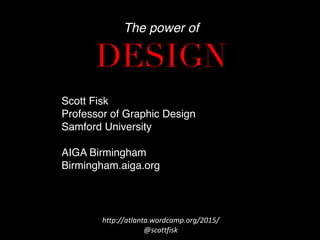Power of Design
- 1. Scott Fisk Professor of Graphic Design Samford University AIGA Birmingham Birmingham.aiga.org âĻ The power ofâĻ DESIGNâĻ http://atlanta.wordcamp.org/2015/ Â @scottfisk Â
- 2. Topics: 1. What is design? 2. Why good design matters. 2. What is good design? 3. Human centered design. 4. Design Basics.âĻ 5. Get inspired! âĻ The power ofâĻ DESIGNâĻ
- 3. What is design? âĻ The power ofâĻ DESIGNâĻ
- 4. What is design? âDesign is thinking made visualâ Saul Bass 1920-1966 âĻ The power ofâĻ DESIGNâĻ
- 5. What is design? Visual problem solving âĻ The power ofâĻ DESIGNâĻ
- 7. WHYâĻ design mattersâĻ âĻ 1st Impression CountsâĻ Brand ManifestationâĻ Credibility User Trust Sticky FactorâĻ Return RateâĻ More SalesâĻ and more importantlyâĶ.âĻ âĻ âĻ âĻ The power ofâĻ DESIGNâĻ
- 10. âĻ POPULAR BRANDSâĻ âĻ âĻ âĻ âĻ âĻ âĻ âĻ âĻ âĻ âĻ âĻ âĻ     Copyright  ÂĐ Â 2014  Interbrand.  All  Rights  Reserved.
- 11. IMPRINTED INTO OUR MEMORY âĻ emotionalâĻ RESPONSEâĻ
- 16. In  broad  terms,  user-Ââcentered  design  (UCD)  is  a  type  of  user  interface  design  and  a  process  in  which  the  needs,  wants,  and  limitations  of  end  users  of  a  product  are  given  extensive  attention  at  each  stage  of  the  design  process. Source:  Wikipedia  http://en.wikipedia.org/wiki/User-Ââcentered_design âĻ HUMANâĻ CENTEREDâĻ
- 17. Gotten lost due to poor signage Failed to figure out direction Failed to figure out how to use a tv remote Burned yourself when you thought cold water was going to come out of the fosset âĻ âĻ âĻ âĻ âĻ âĻ HAVE YOUâĻ EVER?âĻ
- 18. Source: Â http://chriselyea.com/design-Ââlessons-Ââlearned/badly-Ââdesigned-Ââdoors/
- 19. Source: Â http://chriselyea.com/design-Ââlessons-Ââlearned/badly-Ââdesigned-Ââdoors/
- 21. âĻ what does goodâĻ DESIGN ķŲ°ŋ?âĻ
- 25. GRIDS
- 26. GRIDS
- 29. NEGATIVE SPACE
- 30. BRAINSTORMING No wrong answers The obvious answers normally come first Write down or sketch ideas Share ideas with others Do not be in a hurry Be inspired
- 35. calm
- 38. Typography (from the Greek words ÏÏÏÎŋÏ (typos) = form and ÎģÏÎąÏÎŪ (graphe) = writing) is the art and technique of arranging type in order to make language visible. The arrangement of type involves the selection of typefaces, point size, line length, leading (line spacing), adjusting the spaces between groups of letters (tracking) and adjusting the space between pairs of letters (kerning[2]). Typography (from the Greek words ÏÏÏÎŋÏ (typos) = form and ÎģÏÎąÏÎŪ (graphe) = writing) is the art and technique of arranging type in order to make language visible. The arrangement of type involves the selection of typefaces, point size, line length, leading (line spacing), adjusting the spaces between groups of letters (tracking) and adjusting the space between pairs of letters (kerning[2]). âĻ LINE HEIGHT?âĻ âĻ âĻ âĻ âĻ âĻ âĻ âĻ âĻ âĻ âĻ âĻ âĻ
- 44. COLORâĻ When branding how many colors should you use? âĻ âĻ
- 45. CUSTOM âĻ Themes â BenefitsâĻ âĻ
- 50. HOW CANâĻ you prove the success of a design?âĻ âĻ






































![Typography (from the Greek words ÏÏÏÎŋÏ
(typos) = form and ÎģÏÎąÏÎŪ (graphe) =
writing) is the art and technique of
arranging type in order to make language
visible. The arrangement of type involves
the selection of typefaces, point size, line
length, leading (line spacing), adjusting the
spaces between groups of letters (tracking)
and adjusting the space between pairs of
letters (kerning[2]).
Typography (from the Greek words ÏÏÏÎŋÏ
(typos) = form and ÎģÏÎąÏÎŪ (graphe) =
writing) is the art and technique of
arranging type in order to make language
visible. The arrangement of type involves
the selection of typefaces, point size, line
length, leading (line spacing), adjusting the
spaces between groups of letters (tracking)
and adjusting the space between pairs of
letters (kerning[2]).
âĻ
LINE HEIGHT?âĻ
âĻ
âĻ
âĻ
âĻ
âĻ
âĻ
âĻ
âĻ
âĻ
âĻ
âĻ
âĻ](https://image.slidesharecdn.com/powerofdesign-150309152601-conversion-gate01/85/Power-of-Design-38-320.jpg)















